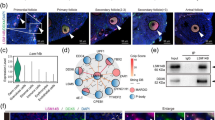Summary
Proper chromosome separation in both mitosis and meiosis depends on the correct connection between kinetochores of chromosomes and spindle microtubules. Kinetochore dysfunction can lead to unequal distribution of chromosomes during cell division and result in aneuploidy, thus kinetochores are critical for faithful segregation of chromosomes. Centromere protein A (CENP-A) is an important component of the inner kinetochore plate. Multiple studies in mitosis have found that deficiencies in CENP-A could result in structural and functional changes of kinetochores, leading to abnormal chromosome segregation, aneuploidy and apoptosis in cells. Here we report the expression and function of CENP-A during mouse oocyte meiosis. Our study found that microinjection of CENP-A blocking antibody resulted in errors of homologous chromosome segregation and caused aneuploidy in eggs. Thus, our findings provide evidence that CENP-A is critical for the faithful chromosome segregation during mammalian oocyte meiosis.
Similar content being viewed by others
References
Akiyoshi B, Biggins S. Reconstituting the kinetochore-microtubule interface: what, why, and how. Chromosoma, 2012,121(3):235–250
Brar GA, Amon A. Emerging roles for centromeres in meiosis I chromosome segregation. Nat Rev Genet, 2008, 9(12):899–910
Verdaasdonk JS, Bloom K. Centromeres: unique chromatin structures that drive chromosome segregation. Nat Rev Mol Cell Biol, 2011,12(5):320–332
Akiyoshi B, Biggins S. Reconstituting the kinetochore-microtubule interface: what, why, and how. Chromosoma, 2012,121(3):235–250
Simerly C, Balczon R, Brinkley B R, et al. Microinjected kinetochore antibodies interfere with chromosome movement in meiotic and mitotic mouse oocytes. J Cell Biol, 1990,111(4):1491–1504
Watanabe Y. Geometry and force behind kinetochore orientation: lessons from meiosis. Nat Rev Mol Cell Biol, 2012,13(6):370–382
Durand-Dubief M, Ekwall K. Heterochromatin tells CENP-A where to go. Bioessays, 2008,30(6):526–529
Sullivan KF, Hechenberger M, Masri K. Human CENP-A contains a histone H3 related histone fold domain that is required for targeting to the centromere. J Cell Biol, 1994,127(3):581–592
Mendiburo MJ, Padeken J, Fulop S, et al. Drosophila CENH3 is sufficient for centromere formation. Science, 2011,334(6056):686–690
Van Hooser AA, Ouspenski II, Gregson HC, et al. Specification of kinetochore-forming chromatin by the histone H3 variant CENP-A. J Cell Sci, 2001,114(Pt 19):3529–3542
Zhang W, Colmenares SU, Karpen GH. Assembly of Drosophila centromeric nucleosomes requires CID dimerization. Mol Cell, 2012,45(2):263–269
Figueroa J, Saffrich R, Ansorge W, et al. Microinjection of antibodies to centromere protein CENP-A arrests cells in interphase but does not prevent mitosis. Chromosoma, 1998,107(6–7):397–405
Goshima G, Kiyomitsu T, Yoda K, et al. Human centromere chromatin protein hMis12, essential for equal segregation, is independent of CENP-A loading pathway. J Cell Biol, 2003,160(1):25–39
Howman EV, Fowler KJ, Newson AJ, et al. Early disruption of centromeric chromatin organization in centromere protein A (Cenpa) null mice. Proc Natl Acad Sci USA, 2000,97(3):1148–1153
Monen J, Maddox PS, Hyndman F, et al. Differential role of CENP-A in the segregation of holocentric C. elegans chromosomes during meiosis and mitosis. Nat Cell Biol, 2005,7(12):1248–1255
Raychaudhuri N, Dubruille R, Orsi GA, et al. Transgenerational propagation and quantitative maintenance of paternal centromeres depends on Cid/Cenp-A presence in Drosophila sperm. PLoS Biol, 2012,10(12):e1001434
Dunleavy EM, Beier NL, Gorgescu W, et al. The cell cycle timing of centromeric chromatin assembly in Drosophila meiosis is distinct from mitosis yet requires CAL1 and CENP-C. PLoS Biol, 2012,10(12):e1001460
Qi ST, Wang ZB, Ouyang YC, et al. Overexpression of SETbeta, a protein localizing to centromeres, causes precocious separation of chromatids during the first meiosis of mouse oocytes. J Cell Sci, 2013,126(Pt 7): 1595–1603
Luo YB, Ma JY, Zhang QH, et al. MBTD1 is associated with Pr-Set7 to stabilize H4K20me1 in mouse oocyte meiotic maturation. Cell Cycle, 2013,12(7):1142–1150
Shelby RD, Monier K, Sullivan KF. Chromatin assembly at kinetochores is uncoupled from DNA replication. J Cell Biol, 2000,151(5):1113–1118
Shelby RD, Vafa O, Sullivan KF. Assembly of CENP-A into centromeric chromatin requires a cooperative array of nucleosomal DNA contact sites. J Cell Biol, 1997, 136(3):501–513
Bodor DL, Valente LP, Mata JF, et al. Assembly in G1 phase and long-term stability are unique intrinsic features of CENP-A nucleosomes. Mol Biol Cell, 2013,24(7):923–932
Kim IS, Lee M, Park KC, et al. Roles of Mis18alpha in epigenetic regulation of centromeric chromatin and CENP-A loading. Mol Cell, 2012,46(3):260–273
Bui M, Dimitriadis EK, Hoischen C, et al. Cell-cycle-dependent structural transitions in the human CENP-A nucleosome in vivo. Cell, 2012,150(2):317–326
Tachiwana H, Kagawa W, Shiga T, et al. Crystal structure of the human centromeric nucleosome containing CENP-A. Nature, 2011,476(7359):232–235
Ranjitkar P, Press MO, Yi X, et al. An E3 ubiquitin ligase prevents ectopic localization of the centromeric histone H3 variant via the centromere targeting domain. Mol Cell, 2010,40(3):455–464
Hewawasam G, Shivaraju M, Mattingly M, et al. Psh1 is an E3 ubiquitin ligase that targets the centromeric histone variant Cse4. Mol Cell, 2010,40(3):444–454
Moreno-Moreno O, Medina-Giro S, Torras-Llort M, et al. The F box protein partner of paired regulates stability of Drosophila centromeric histone H3, CenH3(CID). Curr Biol, 2011,21(17):1488–1493
Sekulic N, Bassett EA, Rogers DJ, et al. The structure of (CENP-A-H4)(2) reveals physical features that mark centromeres. Nature, 2010, 467(7313):347–351
Carroll CW, Milks KJ, Straight AF. Dual recognition of CENP-A nucleosomes is required for centromere assembly. J Cell Biol, 2010,189(7):1143–1155
Black BE, Brock MA, Bedard S, et al. An epigenetic mark generated by the incorporation of CENP-A into centromeric nucleosomes. Proc Natl Acad Sci USA, 2007,104(12):5008–5013
Chiang T, Duncan FE, Schindler K, et al. Evidence that weakened centromere cohesion is a leading cause of age-related aneuploidy in oocytes. Curr Biol, 2010,20(17):1522–1528
Acknowledgements
We thank Shi-wen LI and Hua QIN for their technical help with confocal laser microscopy. We also thank the other members in Dr. Sun’s laboratory for their kind discussions and help.
Author information
Authors and Affiliations
Corresponding author
Additional information
This study was supported by the National Natural Science Foundation of China (No. 30930065 and No. 31271605).
Rights and permissions
About this article
Cite this article
Li, L., Qi, St., Sun, Qy. et al. CENP-A regulates chromosome segregation during the first meiosis of mouse oocytes. J. Huazhong Univ. Sci. Technol. [Med. Sci.] 37, 313–318 (2017). https://doi.org/10.1007/s11596-017-1733-9
Received:
Revised:
Published:
Issue Date:
DOI: https://doi.org/10.1007/s11596-017-1733-9




